Assessment of Thermal Comfort and Air Quality of Room Conditions by Impinging Jet Ventilation Integrated with Ductless Personalized Ventilation
Abstract
1. Introduction
2. Materials and Methods
2.1. Experiment Setup
2.2. Experiment Conditions and Measurement Equipment
2.3. Subjects
2.4. Experiment Procedure and Questionnaires
2.5. Data Analysis
3. Results and Discussion
3.1. Skin Temperature
3.2. Thermal Sensation Votes
3.2.1. Overall Thermal Sensation (OTS)
3.2.2. Local Thermal Sensation
3.3. Thermal Comfort
3.3.1. Thermal Comfort Votes
3.3.2. Thermal Acceptability and Thermal Preference
3.3.3. User Control Choices and Air Movement
3.4. Perceived Air Quality
3.5. Sick Building Syndromes
3.6. Energy Consumption
4. Limitations and Futures Work
5. Conclusions
Author Contributions
Funding
Institutional Review Board Statement
Informed Consent Statement
Data Availability Statement
Acknowledgments
Conflicts of Interest
References
- de Dear, R. Thermal comfort in practice. Indoor Air 2004, 14, 32–39. [Google Scholar] [CrossRef] [PubMed]
- International Energy Agency. Efficiency, Buildings; International Energy Agency: Paris, France, 2018. [Google Scholar]
- Zhao, W.; Kilpeläinen, S.; Kosonen, R.; Jokisalo, J. Experimental comparison of local low velocity unit combined with radiant panel and diffuse ceiling ventilation systems. Indoor Built Environ. 2020, 29, 895–914. [Google Scholar] [CrossRef]
- Chua, K.J.; Chou, S.K.; Yang, W.M.; Yan, J. Achieving better energy-efficient air conditioning—A review of technologies and strategies. Appl. Energy 2013, 104, 87–104. [Google Scholar] [CrossRef]
- Xu, G.; Dong, H.; Xu, Z.; Bhattarai, N. China can reach carbon neutrality before 2050 by improving economic development quality. Energy 2022, 243, 123087. [Google Scholar] [CrossRef]
- Chenari, B.; Carrilho, J.D.; da Silva, M.G. Towards sustainable, energy-efficient and healthy ventilation strategies in buildings: A review. Renew. Sustain. Energy Rev. 2016, 59, 1426–1447. [Google Scholar] [CrossRef]
- Yang, B.; Melikov, A.K.; Kabanshi, A.; Zhang, C.; Bauman, F.S.; Cao, G.; Awbi, H.; Wigö, H.; Niu, J.; Cheong, K.W.D.; et al. A review of advanced air distribution methods-theory, practice, limitations and solutions. Energy Build. 2019, 202, 109359. [Google Scholar] [CrossRef]
- Lin, Z.; Chow, T.; Fong, K.; Tsang, C.; Wang, Q. Comparison of performances of displacement and mixing ventilations. Part II: Indoor air quality. Int. J. Refrig. 2005, 28, 288–305. [Google Scholar] [CrossRef]
- Melikov, A.; Pitchurov, G.; Naydenov, K.; Langkilde, G. Field study on occupant comfort and the office thermal environment in rooms with displacement ventilation. Indoor Air 2005, 15, 205–214. [Google Scholar] [CrossRef]
- Cheng, Y.; Niu, J.; Liu, X.; Gao, N. Experimental and numerical investigations on stratified air distribution systems with special configuration: Thermal comfort and energy saving. Energy Build. 2013, 64, 154–161. [Google Scholar] [CrossRef]
- Halvoňová, B.; Melikov, A.K. Performance of “ductless” personalized ventilation in conjunction with displacement ventilation: Impact of intake height. Build. Environ. 2010, 45, 996–1005. [Google Scholar] [CrossRef]
- Melikov, A. Personalized ventilation. Indoor Air 2004, 14 (Suppl. 7), 157–167. [Google Scholar] [CrossRef] [PubMed]
- Cermak, R.; Melikov, A.; Forejt, L.; Kovář, O. Performance of Personalized Ventilation in Conjunction with Mixing and Displacement Ventilation. HVACR Res. 2006, 12, 295–311. [Google Scholar] [CrossRef]
- Yang, B.; Sekhar, C.; Melikov, A.K. Ceiling mounted personalized ventilation system in hot and humid climate—An energy analysis. Energy Build. 2010, 42, 2304–2308. [Google Scholar] [CrossRef]
- Dalewski, M.; Melikov, A.K.; Vesely, M. Performance of ductless personalized ventilation in conjunction with displacement ventilation: Physical environment and human response. Build. Environ. 2014, 81, 354–364. [Google Scholar] [CrossRef]
- Liu, J.; Dalgo, D.A.; Zhu, S.; Li, H.; Zhang, L.; Srebric, J. Performance analysis of a ductless personalized ventilation combined with radiant floor cooling system and displacement ventilation. Build. Simul. 2019, 12, 905–919. [Google Scholar] [CrossRef]
- Dalewski, M.; Vesely, M.; Melikov, A.K. Ductless personalized ventilation with local air cleaning. In Proceedings of the Healthy Buildings, Brisbane, Australia, 8–12 July 2012; pp. 8–12. [Google Scholar]
- Halvoňová, B.; Melikov, A. Performance of “ductless” personalized ventilation in conjunction with displacement ventilation: Impact of disturbances due to walking person(s). Build. Environ. 2010, 45, 427–436. [Google Scholar] [CrossRef]
- Halvonova, B.; Melikov, A. Performance of Ductless Personalized Ventilation in Conjunction with Displacement Ventilation: Impact of Workstations Layout and Partitions. HVACR Res. 2010, 16, 75–94. [Google Scholar] [CrossRef]
- Alsaad, H.; Voelker, C. CFD Assessment of Thermal Comfort and Indoor Air Quality Using Ductless Personalized Ventilation. In Proceedings of the 15th IBPSA Conference, San Francisco, CA, USA, 7–9 August 2017; p. 9. [Google Scholar]
- Alsaad, H.; Voelker, C. Performance evaluation of ductless personalized ventilation in comparison with desk fans using numerical simulations. Indoor Air 2020, 30, 776–789. [Google Scholar] [CrossRef]
- Katramiz, E.; Ghaddar, N.; Ghali, K. Novel personalized chair-ventilation design integrated with displacement ventilation for cross-contamination mitigation in classrooms. Build. Environ. 2022, 213, 108885. [Google Scholar] [CrossRef]
- Lelong, C.; Dalewski, M.; Melikov, A.K. Energy Analysis of the Ductless Personalized Ventilation. In Proceedings of the 11th REHVA World Congress and the 8th International Conference on Indoor Air Quality, Ventilation and Energy Conservation in Buildings, Prague, Czech Republic, 16–19 June 2013; p. 10. [Google Scholar]
- Cho, Y.; Awbi, H.; Karimipanah, T. Theoretical and experimental investigation of impinging jet ventilation and comparison with wall displacement ventilation. Build. Environ. 2002, 37, 1329–1342. [Google Scholar] [CrossRef]
- Cao, G.; Awbi, H.; Yao, R.; Fan, Y.; Sirén, K.; Kosonen, R.; Zhang, J.J. A review of the performance of different ventilation and airflow distribution systems in buildings. Build. Environ. 2014, 73, 171–186. [Google Scholar] [CrossRef]
- Yamasawa, H.; Kobayashi, T.; Yamanaka, T.; Choi, N.; Matsuzaki, M. Experimental investigation of difference in indoor environment using impinging jet ventilation and displacement ventilation systems. Int. J. Vent. 2020, 21, 229–246. [Google Scholar] [CrossRef]
- Karimipanah, T.; Sandberg, M.; Awbi, H.B. A comparative study of different air distribution systems in a classroom. In Proceedings of the Roomvent, England, UK, 9–12 July 2000; Volume 2, pp. 1013–1018. [Google Scholar]
- Awbi, H.B. Ventilation for good indoor air quality and energy efficiency. Energy Procedia 2017, 112, 277–286. [Google Scholar] [CrossRef]
- Liu, P.; Yang, B. Performance evaluation of impinging jet ventilation combined with ductless personalized ventilation. E3S Web Conf. 2022, 356, 01052. [Google Scholar] [CrossRef]
- Su, W.; Yang, B.; Zhou, B.; Wang, F.; Li, A. A novel convection and radiation combined terminal device: Its impact on occupant thermal comfort and cognitive performance in winter indoor environments. Energy Build. 2021, 246, 111123. [Google Scholar] [CrossRef]
- Lan, L.; Lian, Z. Application of statistical power analysis—How to determine the right sample size in human health, comfort and productivity research. Build. Environ. 2010, 45, 1202–1213. [Google Scholar] [CrossRef]
- ANSI/ASHRAE Standard 55–2020; Thermal Environmental Conditions for Human Occupancy. ANSI: New York, NY, USA; ASHRAE: Atlanta, GA, USA, 2020.
- Melikov, A.K.; Kaczmarczyk, J. Air movement and perceived air quality. Build. Environ. 2012, 47, 400–409. [Google Scholar] [CrossRef]
- Burge, P.S. Sick building syndrome. Occup. Environ. Med. 2004, 61, 185–190. [Google Scholar] [CrossRef]
- Pallubinsky, H.; Schellen, L.; Rieswijk, T.; Breukel, C.; Kingma, B.; van Marken Lichtenbelt, W. Local cooling in a warm environment. Energy Build. 2016, 113, 15–22. [Google Scholar] [CrossRef]
- Szodrai, F.; Kalmár, F. Simulation of temperature distribution on the face skin in case of advanced personalized ventilation system. Energies 2019, 12, 1185. [Google Scholar] [CrossRef]
- Yang, B.; Melikov, A.; Sekhar, C. Performance Evaluation of Ceiling Mounted Personalized Ventilation System. ASHRAE Trans. 2009, 115, 395–406. [Google Scholar]
- Fang, Z.; Liu, H.; Li, B.; Tan, M.; Olaide, O.M. Experimental investigation on thermal comfort model between local thermal sensation and overall thermal sensation. Energy Build. 2018, 158, 1286–1295. [Google Scholar] [CrossRef]
- Yang, H.; Cao, B.; Ju, Y.; Zhu, Y. The effects of local cooling at different torso parts in improving body thermal comfort in hot indoor environments. Energy Build. 2019, 198, 528–541. [Google Scholar] [CrossRef]
- He, Y.; Li, N.; Huang, Q. A field study on thermal environment and occupant local thermal sensation in offices with cooling ceiling in Zhuhai, China. Energy Build. 2015, 102, 277–283. [Google Scholar] [CrossRef]
- Yang, B.; Lei, T.-H.; Yang, P.; Liu, K.; Wang, F. On the Use of Wearable Face and Neck Cooling Fans to Improve Occupant Thermal Comfort in Warm Indoor Environments. Energies 2021, 14, 8077. [Google Scholar] [CrossRef]
- Zhou, B.; Yang, B.; Wu, M.; Guo, Y.; Wang, F.; Li, A. Draught sensation assessment in an occupied space heated by stratified ventilation system: Attachment ventilation with relayed fans. Build. Environ. 2022, 207, 108500. [Google Scholar] [CrossRef]
- Fountain, M.; Arens, E.; de Dear, R.; Bauman, F.; Miura, K. Locally Controlled Air Movement Preferred in Warm Isothermal Environments; UC Berkeley, Center for the Built Environment: Berkeley, CA, USA, 1994; Volume 100, pp. 93–952. [Google Scholar]
- Zhang, H.; Arens, E.; Fard, S.A.; Huizenga, C.; Paliaga, G.; Brager, G.; Zagreus, L. Air movement preferences observed in office buildings. Int. J. Biometeorol. 2007, 51, 349–360. [Google Scholar] [CrossRef]
- Zhai, Y.; Zhang, H.; Zhang, Y.; Pasut, W.; Arens, E.; Meng, Q. Comfort under personally controlled air movement in warm and humid environments. Build. Environ. 2013, 65, 109–117. [Google Scholar] [CrossRef]
- Yang, B.; Sekhar, S.; Melikov, A.K. Ceiling-mounted personalized ventilation system integrated with a secondary air distribution system–a human response study in hot and humid climate. Indoor Air 2010, 20, 309–319. [Google Scholar] [CrossRef]
- Wolkoff, P. “Healthy” eye in office-like environments. Environ. Int. 2008, 34, 1204–1214. [Google Scholar] [CrossRef]
- Parkinson, T.; de Dear, R. Thermal pleasure in built environments: Spatial alliesthesia from air movement. Build. Res. Inf. 2017, 45, 320–335. [Google Scholar] [CrossRef]

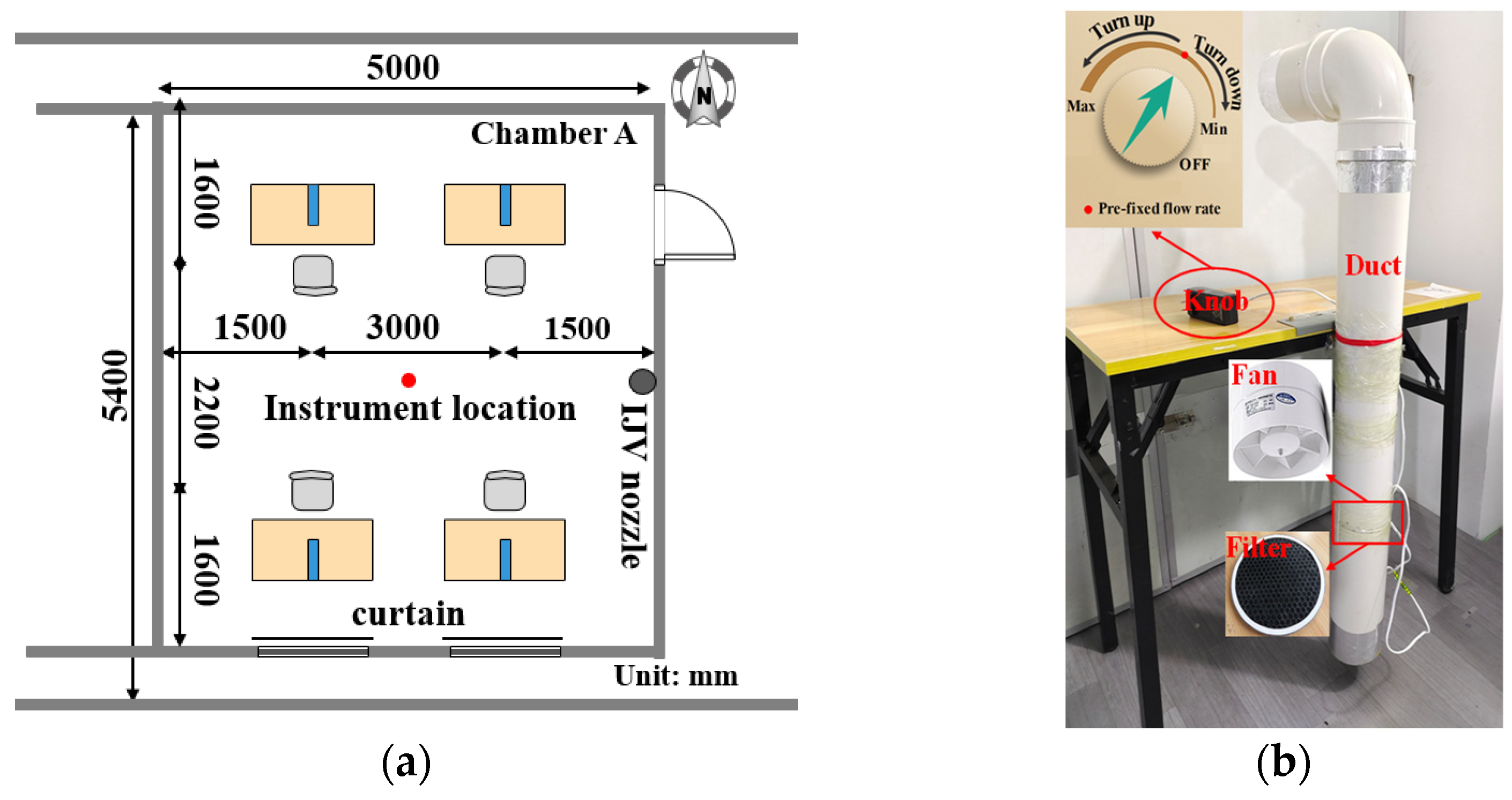

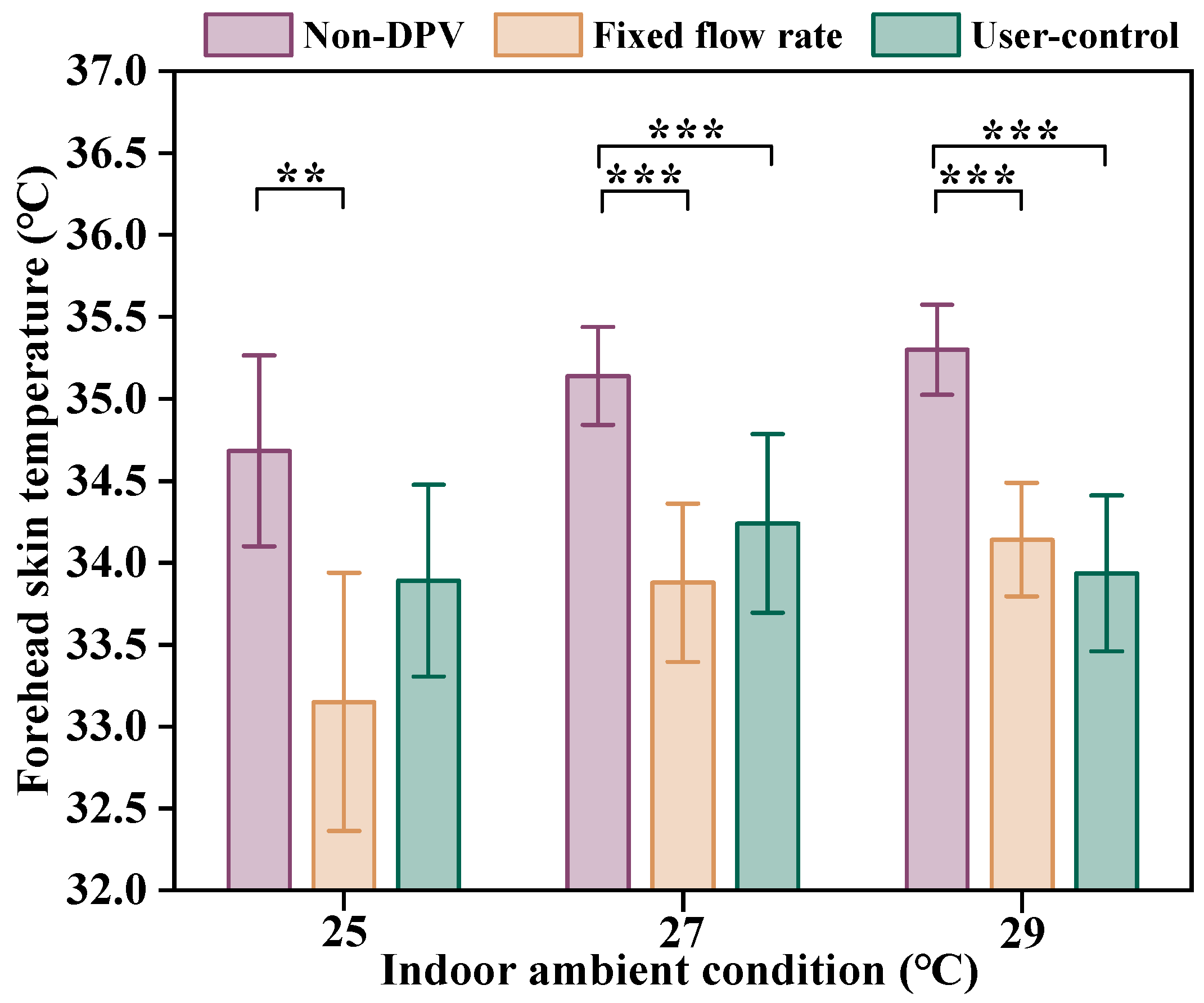

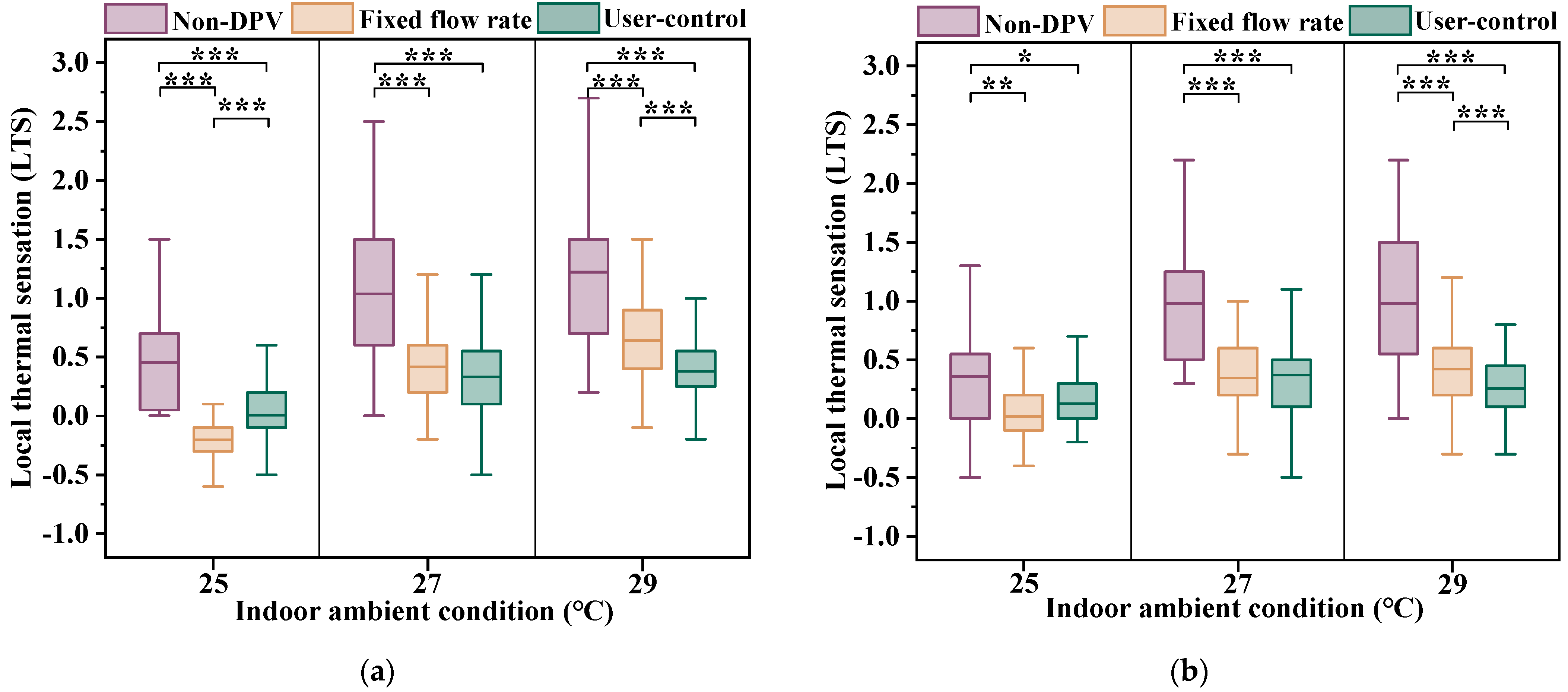


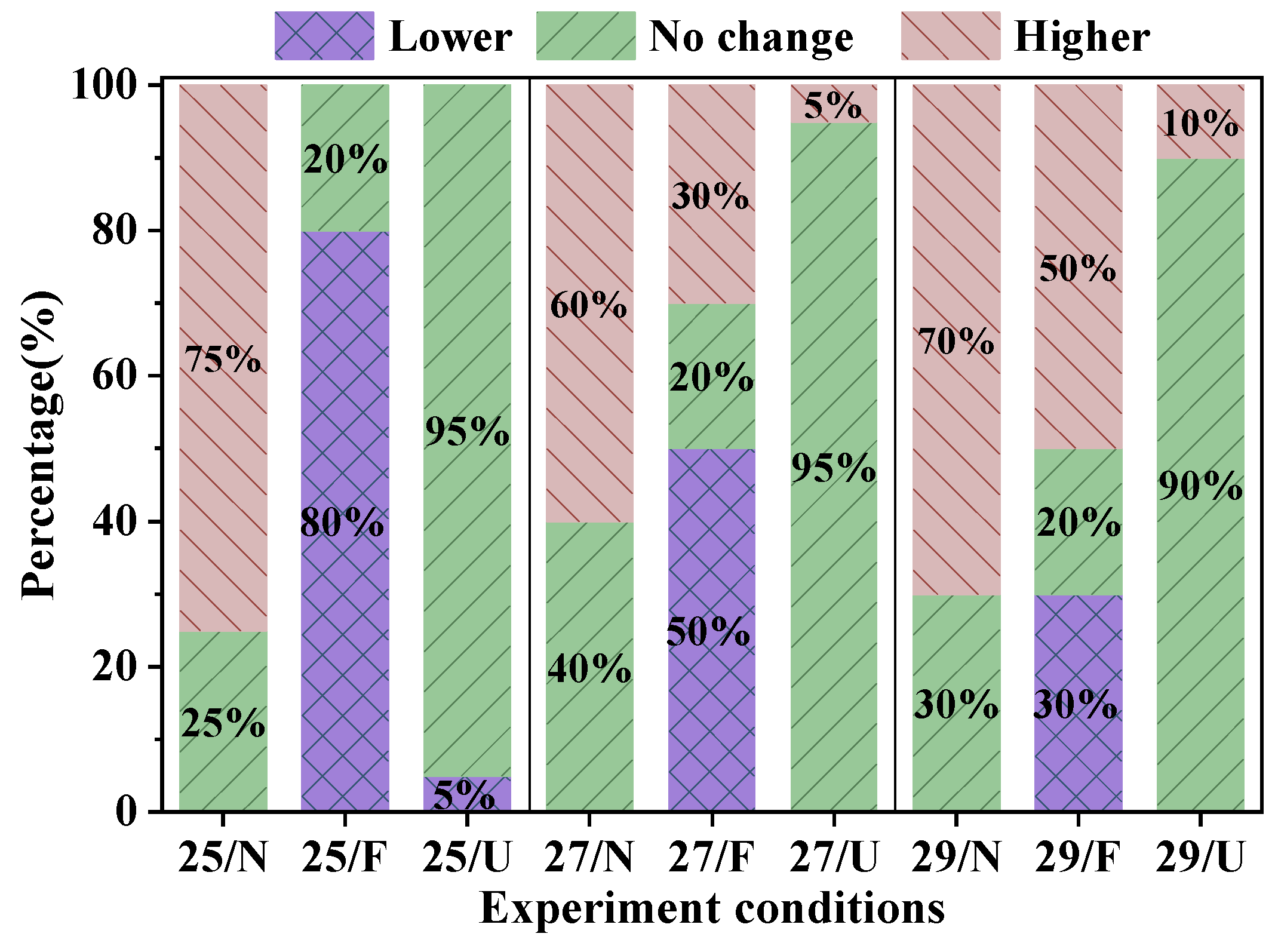

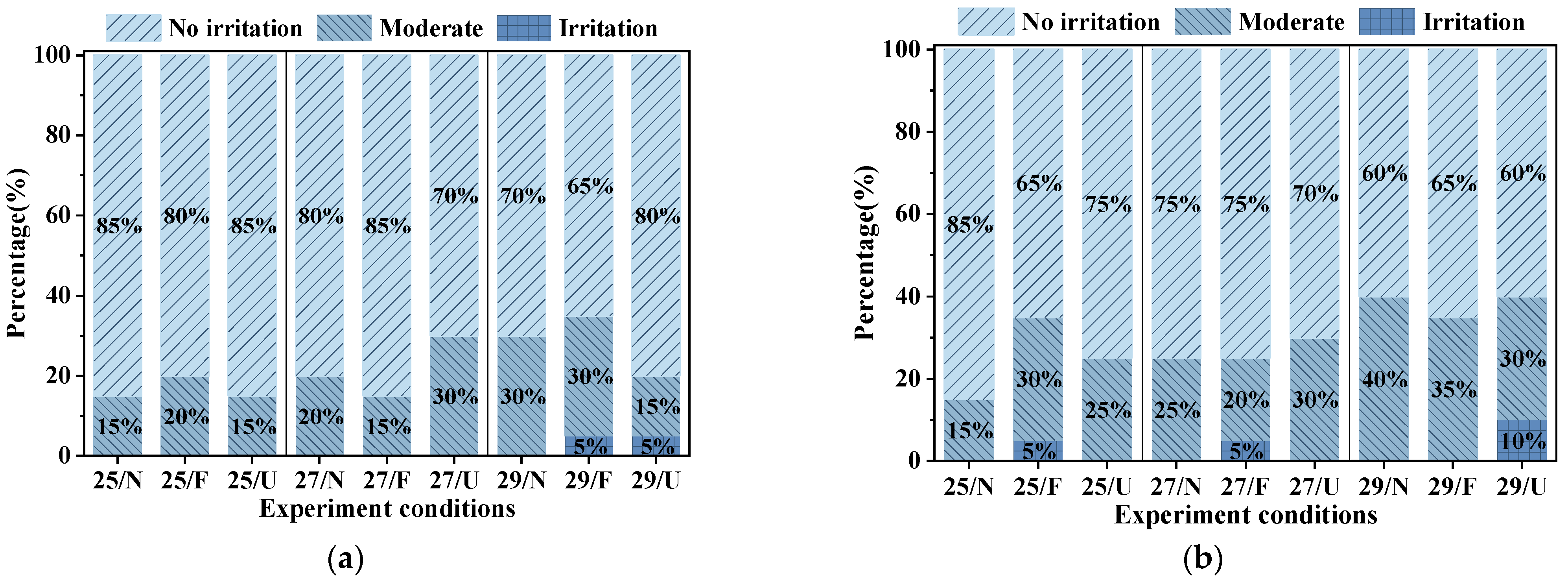
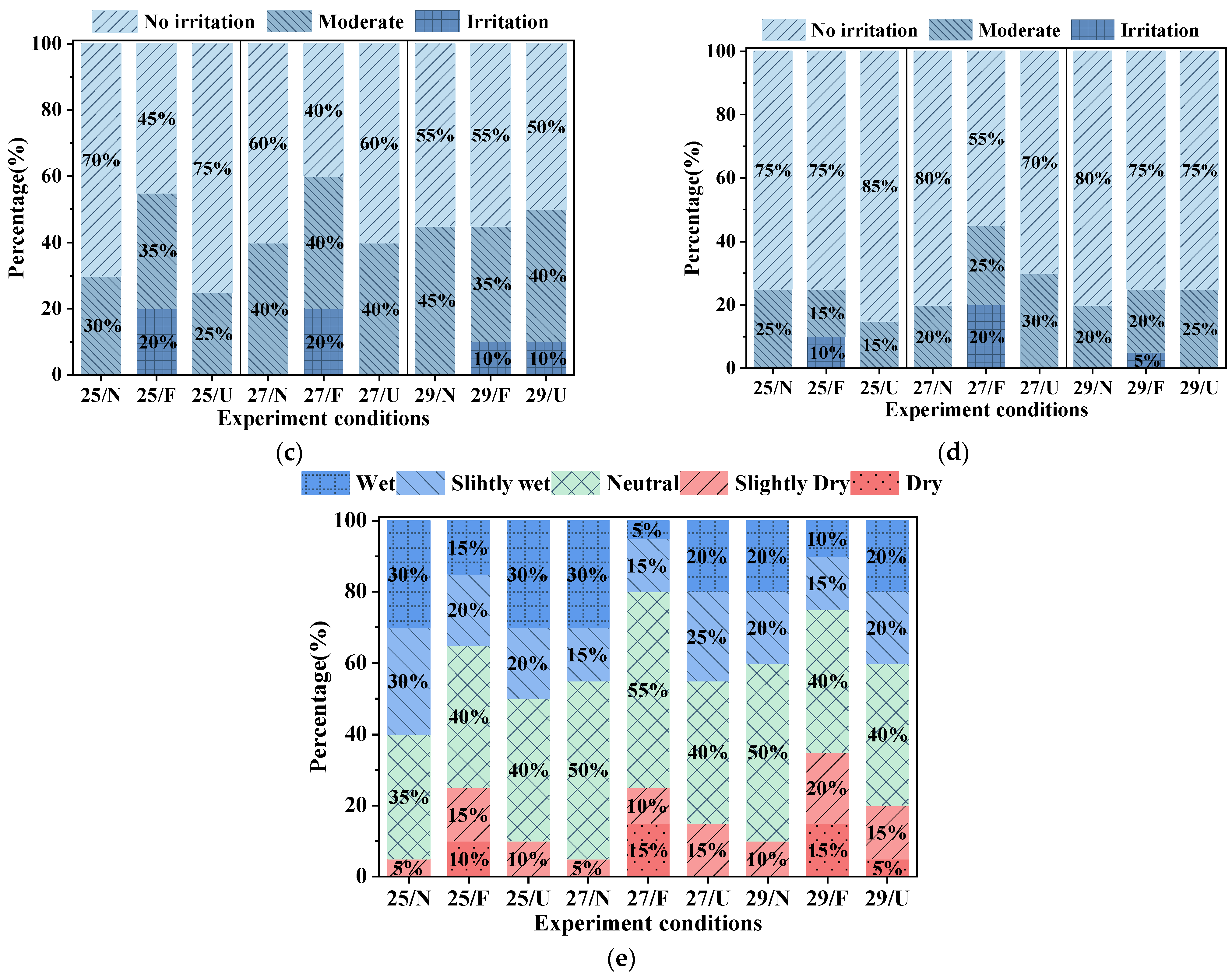
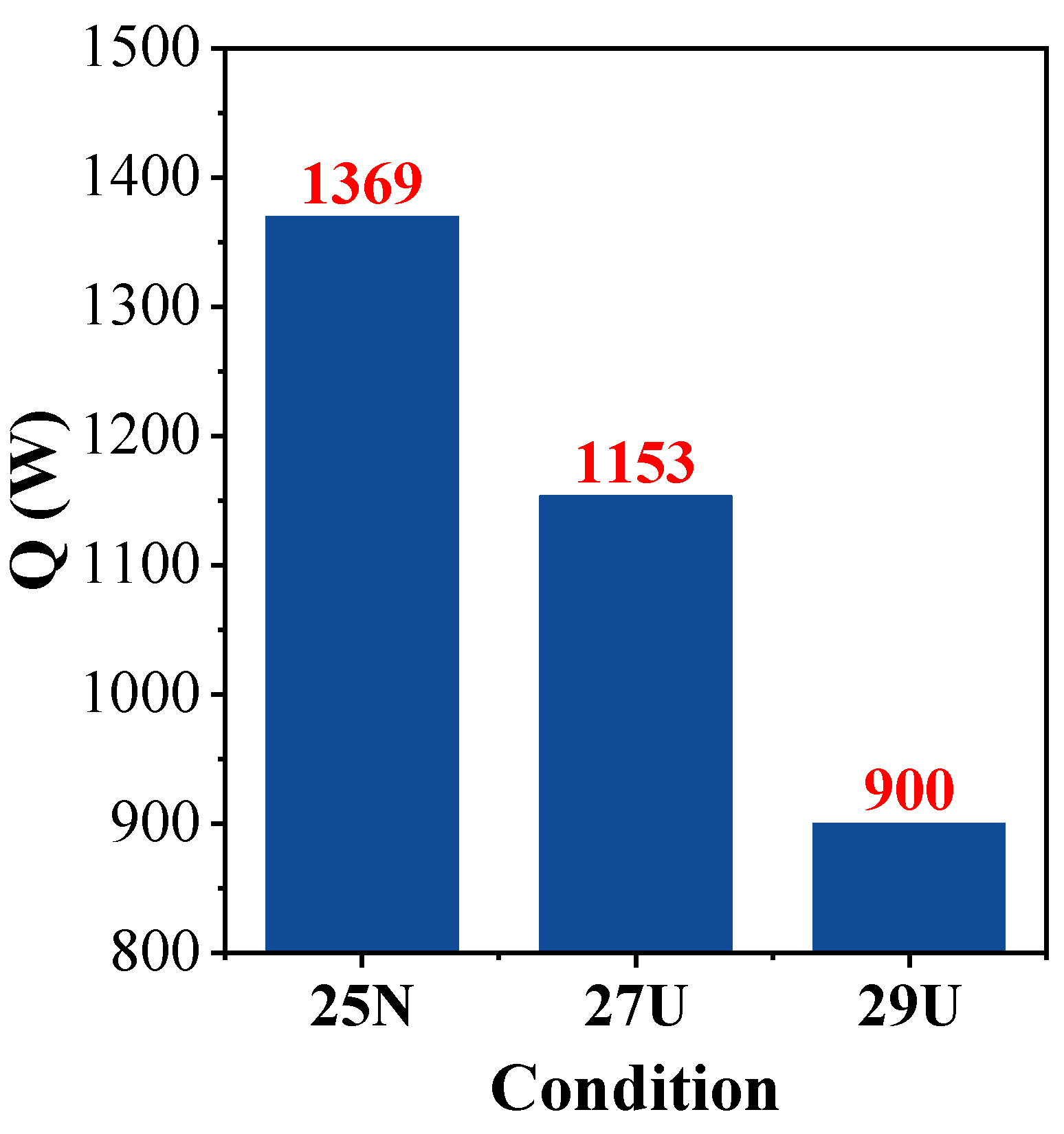
| Condition | Temperature at 1.1 m (°C) | Supply Air Temperature (°C) | The Supply Flow Rate of IJV (L/s) | CO2 Concentration at 1.1 m (ppm) |
|---|---|---|---|---|
| 1 | 25.2 ± 0.3 | 21.1 ± 0.1 | 98 | 572 ± 23 |
| 2 | 27.3 ± 0.2 | 22.0 ± 0.1 | 84 | 590 ± 30 |
| 3 | 28.8 ± 0.2 | 22.8 ± 0.2 | 70 | 628 ± 28 |
| Gender | Age (yr) | Height (m) | Weight (kg) | Body Mass Index (kg/m2) |
|---|---|---|---|---|
| Males | 23.8 ± 1.7 | 1.76 ± 0.04 | 68.10 ± 8.11 | 21.8 ± 1.87 |
| Females | 22.7 ± 2.0 | 1.61 ± 0.06 | 55.03 ± 4.94 | 21.3 ± 1.75 |
| Total | 20.8 ± 1.8 | 1.69 ± 0.09 | 61.70 ± 9.28 | 21.5 ± 1.83 |
| Turn Down | No Change | Turn Up | |
|---|---|---|---|
| 25 °C | 70% | 25% | 5% |
| 27 °C | 45% | 15% | 40% |
| 29 °C | 30% | 15% | 55% |
Publisher’s Note: MDPI stays neutral with regard to jurisdictional claims in published maps and institutional affiliations. |
© 2022 by the authors. Licensee MDPI, Basel, Switzerland. This article is an open access article distributed under the terms and conditions of the Creative Commons Attribution (CC BY) license (https://creativecommons.org/licenses/by/4.0/).
Share and Cite
Yang, B.; Liu, P.; Liu, Y.; Jin, D.; Wang, F. Assessment of Thermal Comfort and Air Quality of Room Conditions by Impinging Jet Ventilation Integrated with Ductless Personalized Ventilation. Sustainability 2022, 14, 12526. https://doi.org/10.3390/su141912526
Yang B, Liu P, Liu Y, Jin D, Wang F. Assessment of Thermal Comfort and Air Quality of Room Conditions by Impinging Jet Ventilation Integrated with Ductless Personalized Ventilation. Sustainability. 2022; 14(19):12526. https://doi.org/10.3390/su141912526
Chicago/Turabian StyleYang, Bin, Pengju Liu, Yihang Liu, Dacheng Jin, and Faming Wang. 2022. "Assessment of Thermal Comfort and Air Quality of Room Conditions by Impinging Jet Ventilation Integrated with Ductless Personalized Ventilation" Sustainability 14, no. 19: 12526. https://doi.org/10.3390/su141912526
APA StyleYang, B., Liu, P., Liu, Y., Jin, D., & Wang, F. (2022). Assessment of Thermal Comfort and Air Quality of Room Conditions by Impinging Jet Ventilation Integrated with Ductless Personalized Ventilation. Sustainability, 14(19), 12526. https://doi.org/10.3390/su141912526








